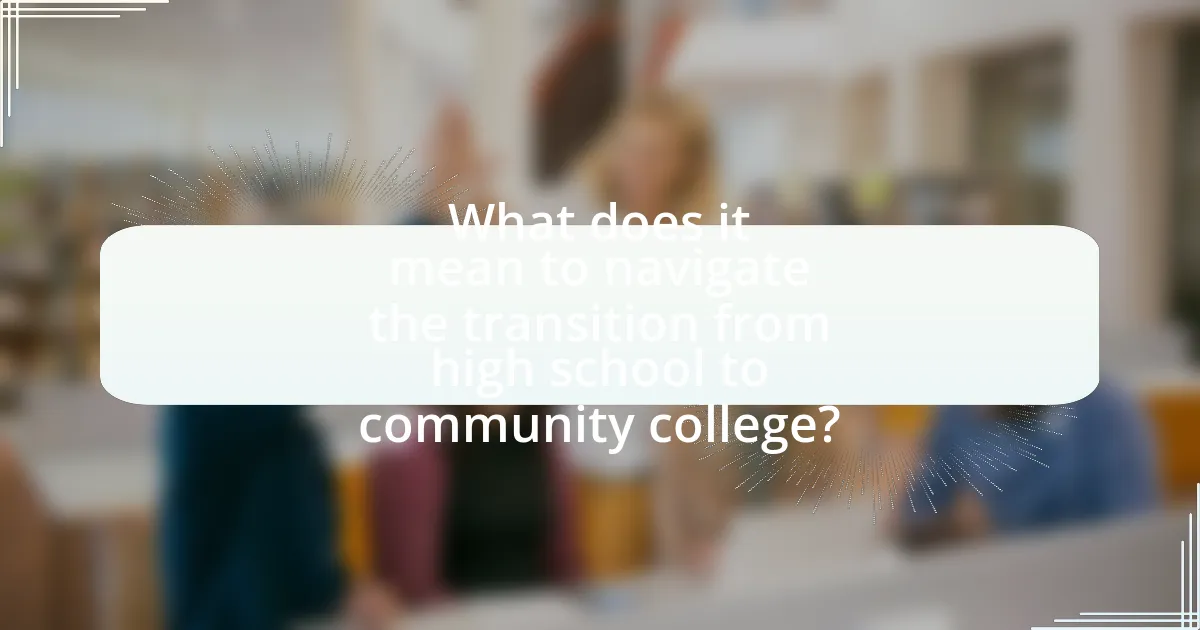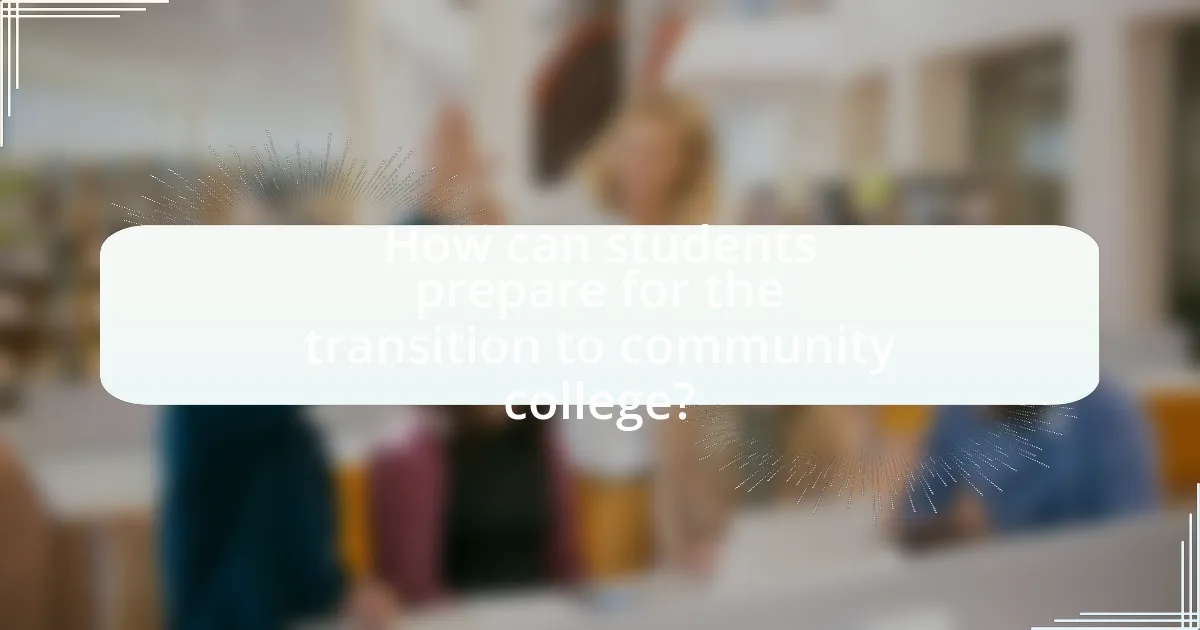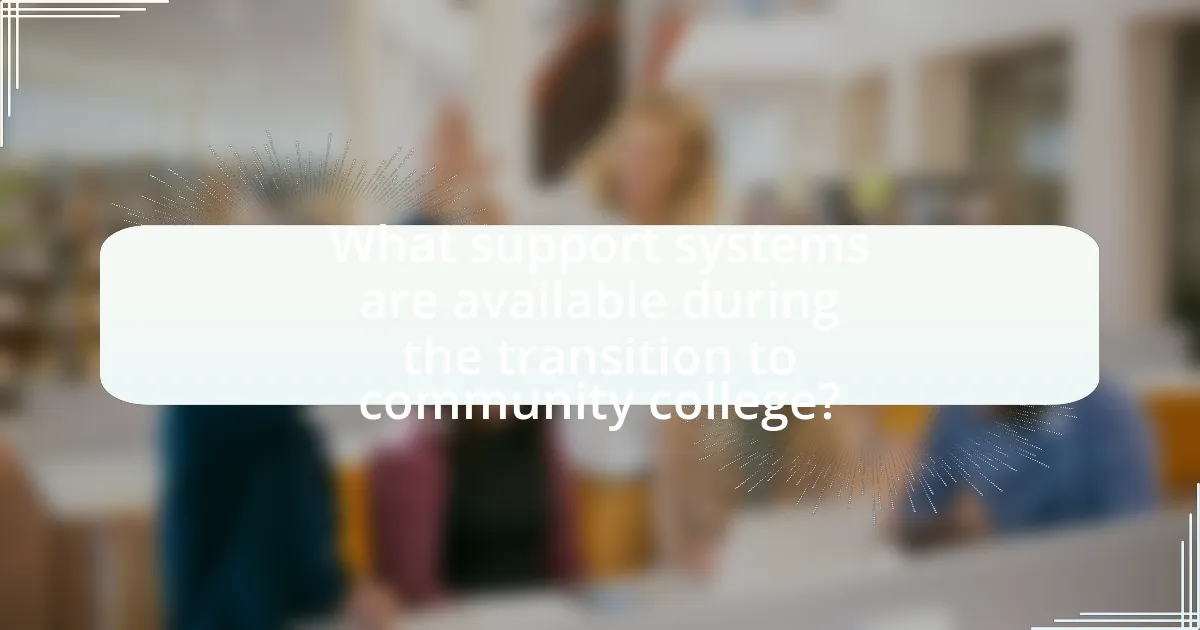Navigating the transition from high school to community college involves adapting to a new educational environment characterized by increased independence and responsibility. This article examines the significance of this transition, highlighting the academic and personal development opportunities it presents, as well as the challenges students may face, such as academic adjustment and time management. It also discusses the differences between high school and community college, including academic expectations and social environments, while providing strategies for preparation, effective study habits, and available support systems. Additionally, the article outlines financial resources and best practices to ensure a successful transition, emphasizing the importance of setting realistic goals and avoiding common pitfalls.

What does it mean to navigate the transition from high school to community college?
Navigating the transition from high school to community college means adapting to a new educational environment that emphasizes greater independence and responsibility. This transition involves understanding academic expectations, managing time effectively, and utilizing available resources such as academic advising and tutoring services. Research indicates that students who actively engage with support systems during this transition are more likely to succeed; for instance, a study by the National Center for Education Statistics shows that community college students who seek academic support have higher retention rates.
Why is this transition significant for students?
The transition from high school to community college is significant for students because it marks a critical shift in their educational journey, impacting their academic and personal development. This transition provides students with opportunities to gain independence, explore diverse fields of study, and develop essential skills for future employment. Research indicates that community college can serve as a bridge to higher education, with approximately 80% of students who transfer from community colleges to four-year institutions successfully completing their degrees. This pathway enhances students’ chances of achieving their long-term career goals and contributes to their overall success in the workforce.
What challenges do students face during this transition?
Students face several challenges during the transition from high school to community college, including academic adjustment, time management, and social integration. Academic adjustment is significant as students encounter a more rigorous curriculum and different teaching styles, which can lead to difficulties in maintaining grades. Time management becomes crucial as students must balance coursework, work, and personal responsibilities, often for the first time. Social integration poses another challenge, as students may struggle to form new relationships and navigate a less structured environment compared to high school. These challenges are supported by research indicating that nearly 30% of community college students report feeling unprepared for the academic demands they face (National Center for Education Statistics, 2020).
How can understanding this transition benefit students?
Understanding the transition from high school to community college benefits students by equipping them with essential skills and knowledge to navigate academic and social challenges effectively. This understanding allows students to set realistic expectations, develop time management skills, and adapt to a more independent learning environment. Research indicates that students who are well-prepared for this transition are more likely to persist in their studies and achieve academic success, as highlighted in the study “The Impact of Transition Programs on Student Success” by the National Center for Education Statistics. This preparation fosters confidence and enhances students’ ability to utilize available resources, ultimately leading to a smoother adjustment and improved educational outcomes.
What are the key differences between high school and community college?
High school and community college differ primarily in structure, academic expectations, and student autonomy. High school typically follows a set curriculum mandated by state education standards, while community college offers a wider range of courses and programs that students can choose based on their interests and career goals. In high school, attendance is often compulsory, and students are closely monitored by teachers and parents, whereas community college students enjoy greater independence and are responsible for managing their own schedules and academic progress. Additionally, community college courses generally require a higher level of critical thinking and self-directed learning compared to high school classes, reflecting the transition to a more adult learning environment.
How do academic expectations differ between the two?
Academic expectations differ significantly between high school and community college. In high school, educators often provide structured guidance and closely monitor student progress, while community college emphasizes self-directed learning and personal responsibility. For instance, high school students typically have a set schedule with daily attendance requirements and frequent assessments, whereas community college students may have more flexible schedules, fewer class meetings, and a greater emphasis on independent study. This shift requires community college students to develop time management skills and take initiative in their learning, as they are expected to engage with course materials outside of class more extensively.
What changes occur in the social environment during this transition?
During the transition from high school to community college, significant changes occur in the social environment, including shifts in peer relationships, increased independence, and exposure to diverse social groups. High school often features a more structured social setting with established friendships, while community college introduces a broader array of individuals from various backgrounds, fostering new connections. Research indicates that this transition can lead to enhanced social skills and adaptability, as students navigate different social dynamics and engage in collaborative learning environments. Additionally, the increased autonomy in community college encourages students to form their own social networks, which can positively impact their academic and personal development.

How can students prepare for the transition to community college?
Students can prepare for the transition to community college by developing effective study habits, understanding the college’s resources, and familiarizing themselves with the course requirements. Establishing a consistent study schedule helps students manage their time effectively, which is crucial for success in a more independent learning environment. Additionally, students should explore academic support services, such as tutoring and counseling, which are often available at community colleges to assist with the transition. Familiarizing themselves with the course catalog and degree requirements enables students to make informed decisions about their academic paths. Research indicates that students who actively engage with these resources are more likely to succeed in their college endeavors.
What steps should students take before enrolling?
Students should conduct thorough research on community colleges before enrolling. This includes reviewing program offerings, understanding admission requirements, and evaluating financial aid options. According to the American Association of Community Colleges, over 1,000 community colleges in the U.S. provide diverse programs tailored to local workforce needs, making it essential for students to align their interests with available courses. Additionally, students should visit campuses, if possible, to gain firsthand experience of the environment and resources. Engaging with current students and faculty can provide valuable insights into the college experience.
How can students assess their readiness for community college?
Students can assess their readiness for community college by evaluating their academic skills, time management abilities, and personal motivation. Academic skills can be gauged through standardized tests, such as the SAT or ACT, which provide insight into a student’s proficiency in subjects like math and reading. Time management abilities can be assessed by reflecting on past experiences in balancing schoolwork, extracurricular activities, and personal commitments. Personal motivation can be evaluated by considering one’s goals for attending community college and the commitment to achieving those goals. Research indicates that students who engage in self-assessment and seek feedback from teachers or counselors are more likely to succeed in their transition to community college.
What resources are available to help with preparation?
Resources available to help with preparation for transitioning from high school to community college include academic advising services, tutoring programs, and orientation sessions. Academic advising services provide personalized guidance on course selection and degree requirements, ensuring students understand their educational pathways. Tutoring programs offer additional academic support in various subjects, helping students strengthen their skills before college-level coursework. Orientation sessions familiarize incoming students with campus resources, academic expectations, and social opportunities, facilitating a smoother transition. These resources are essential for building a strong foundation for success in community college.
How can students effectively manage their time and responsibilities?
Students can effectively manage their time and responsibilities by implementing structured planning techniques, such as creating a detailed schedule that prioritizes tasks based on deadlines and importance. Research indicates that students who utilize time management tools, like planners or digital calendars, report higher academic performance and reduced stress levels. For instance, a study published in the Journal of Educational Psychology found that students who set specific goals and organized their study time were 20% more likely to achieve higher grades compared to those who did not. By consistently reviewing and adjusting their schedules, students can ensure they allocate sufficient time for both academic and personal responsibilities, leading to a more balanced and productive college experience.
What strategies can help students balance academics and personal life?
Students can balance academics and personal life by implementing effective time management strategies. Prioritizing tasks using tools like planners or digital calendars helps students allocate specific time slots for studying, attending classes, and engaging in personal activities. Research indicates that students who utilize time management techniques report lower stress levels and improved academic performance. For instance, a study published in the Journal of Educational Psychology found that effective time management is positively correlated with academic success, highlighting its importance in maintaining a balanced lifestyle. Additionally, setting clear boundaries between study time and personal time allows students to recharge and maintain their well-being, further supporting their academic endeavors.
How can students develop effective study habits for community college?
Students can develop effective study habits for community college by establishing a consistent study schedule, utilizing active learning techniques, and creating a conducive study environment. A consistent study schedule helps students allocate specific times for studying, which can improve retention and understanding of material. Active learning techniques, such as summarizing information, teaching concepts to peers, and practicing retrieval, enhance engagement and comprehension. Additionally, a conducive study environment, free from distractions and equipped with necessary resources, supports focus and productivity. Research indicates that students who implement structured study habits tend to achieve higher academic performance, as evidenced by a study published in the Journal of Educational Psychology, which found that organized study practices correlate with improved grades and retention rates.

What support systems are available during the transition to community college?
Support systems available during the transition to community college include academic advising, tutoring services, orientation programs, and counseling services. Academic advising helps students understand course requirements and develop educational plans, while tutoring services provide additional academic support in various subjects. Orientation programs familiarize new students with campus resources and expectations, and counseling services offer emotional and psychological support to help students navigate challenges. These systems are designed to enhance student success and retention rates, as evidenced by studies showing that students who engage with support services are more likely to persist in their studies.
How can academic advising assist students in this transition?
Academic advising can assist students in the transition from high school to community college by providing personalized guidance on course selection, academic resources, and career planning. This support helps students navigate the complexities of college requirements and fosters a smoother adjustment to the academic environment. Research indicates that students who engage with academic advisors are more likely to persist in their studies and achieve their educational goals, as they receive tailored advice that aligns with their individual needs and aspirations.
What role do tutoring services play in supporting students?
Tutoring services play a crucial role in supporting students by providing personalized academic assistance that enhances understanding and retention of course material. These services help bridge knowledge gaps, particularly for students transitioning from high school to community college, where academic expectations may differ significantly. Research indicates that students who utilize tutoring services often experience improved grades and increased confidence in their abilities, as evidenced by a study published in the Journal of Educational Psychology, which found that students receiving tutoring showed a 12% increase in academic performance compared to their peers who did not seek help. This support system not only aids in academic success but also fosters essential skills such as time management and study strategies, further facilitating a smoother transition into higher education.
How can peer support groups enhance the transition experience?
Peer support groups can enhance the transition experience by providing emotional support, practical advice, and a sense of belonging. These groups facilitate connections among individuals facing similar challenges, which can reduce feelings of isolation and anxiety during the transition from high school to community college. Research indicates that students who engage in peer support are more likely to persist in their studies and achieve academic success, as they benefit from shared experiences and collective problem-solving. For instance, a study published in the Journal of College Student Development found that peer mentoring programs significantly improved students’ adjustment and retention rates, highlighting the effectiveness of peer support in easing transitions.
What financial resources can help students during this transition?
Financial resources that can help students during the transition from high school to community college include federal financial aid, scholarships, grants, and work-study programs. Federal financial aid, such as Pell Grants, provides need-based assistance to eligible students, with the maximum award for the 2023-2024 academic year being $7,395. Scholarships, which can be merit-based or need-based, are offered by various organizations and institutions, helping to cover tuition and other expenses. Additionally, state grants, like the California College Promise Grant, offer tuition waivers for eligible students, further easing financial burdens. Work-study programs allow students to earn money while attending school, providing both financial support and valuable work experience. These resources collectively support students in managing the costs associated with their education during this critical transition.
How can students apply for financial aid and scholarships?
Students can apply for financial aid and scholarships by completing the Free Application for Federal Student Aid (FAFSA) and researching scholarship opportunities through their prospective community college’s financial aid office. The FAFSA is essential as it determines eligibility for federal and state financial aid, including grants and loans. Additionally, community colleges often provide lists of available scholarships, which may have specific eligibility criteria and application processes. According to the National Center for Education Statistics, approximately 70% of undergraduate students receive some form of financial aid, highlighting the importance of applying for these resources.
What budgeting tips can help students manage their finances in community college?
Students can effectively manage their finances in community college by creating a detailed budget that tracks income and expenses. This budget should include fixed costs such as tuition, fees, and rent, as well as variable expenses like groceries and entertainment. According to a report from the National Center for Education Statistics, 60% of community college students work while attending school, making it crucial to balance work hours with academic commitments. Additionally, students should prioritize essential expenses and consider using student discounts and financial aid options to reduce costs. By regularly reviewing and adjusting their budget, students can maintain financial stability throughout their college experience.
What are some best practices for a successful transition to community college?
To ensure a successful transition to community college, students should engage in thorough preparation, including researching programs and understanding admission requirements. This preparation allows students to align their academic goals with the offerings of the community college, which often includes a variety of degree and certificate programs. Additionally, students should attend orientation sessions, as these provide essential information about campus resources, academic advising, and support services. Engaging with academic advisors can help students create a tailored course schedule that meets their educational objectives. Furthermore, developing strong time management and study skills is crucial, as community college coursework can be more demanding than high school. According to the National Center for Education Statistics, students who actively participate in orientation and advising are more likely to persist in their studies and achieve their academic goals.
How can students set realistic goals for their first semester?
Students can set realistic goals for their first semester by assessing their strengths, weaknesses, and available resources. This involves evaluating their academic skills, time management abilities, and support systems, such as tutoring or counseling services. Research indicates that students who set specific, measurable, achievable, relevant, and time-bound (SMART) goals are more likely to succeed; for instance, a study published in the Journal of Educational Psychology found that goal-setting significantly enhances academic performance. By focusing on manageable objectives, such as maintaining a certain GPA or completing assignments on time, students can create a structured plan that aligns with their capabilities and commitments.
What common pitfalls should students avoid during this transition?
Students should avoid procrastination during the transition from high school to community college. Procrastination can lead to increased stress and lower academic performance, as students may struggle to keep up with assignments and deadlines. Research indicates that students who manage their time effectively are more likely to succeed academically, highlighting the importance of establishing a structured schedule early on. Additionally, students should avoid underestimating the importance of seeking help; many community colleges offer resources such as tutoring and counseling, which can significantly aid in their adjustment. Engaging with these resources can enhance understanding and retention of course material, ultimately leading to better outcomes.

Leave a Reply